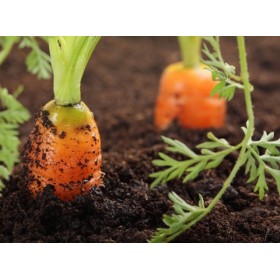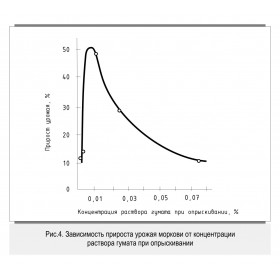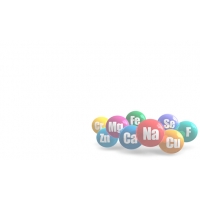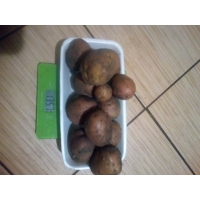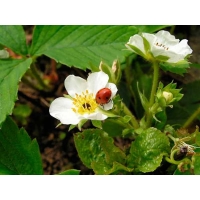The optimized and critical concentration of humate solution
Theoretical substantiation and practical confirmation of optimal concentration of potassic humate solution are given. The analysis of possible ranges of potassic humate concentration at various methods of its application was carried out.
Among the factors that determine the level of humates effectiveness, it is necessary to include the content and qualitative characteristics of biologically active substances, the concentration and dose of spray materials, soil condition, temperature, humidity, etc. However, in other equal conditions, the effectiveness of humates is determined by two factors – concentration in solution and dose. The concentration of humate in the solution is measured in mg/l or in %, and the dose – in kg/ha, g/m2 of surface, or in kg/m3 of the volume of the active layer of soil. Both of these factors are directly dependent on the method of application: presowing soaking of seeds, foliar (non-root) nutrition of plants with aqueous solutions or the introduction of humate directly into the soil. Each of these methods requires different optimal concentrations and doses.
The interval of the optimal area with changing factors, in which the positive effect of humates exerts most strongly, may not be very broad. Therefore, sometimes it must be determined experimentally, conducting a series of control experiments with a fairly small step. For a sure reproduction of the optimum found, humic preparations with a higher stability of properties than those previously applied should be used.
"AGROBIO" staff members determined in an experimental way that the highest biological activity foliar nutrition exerts an aqueous solution with a humate concentration of 0.005-0.009% by AI (active ingredient). In further researches of many scientists and agronomists solutions of this concentration were used.
The optimum stimulating effect of humate during biotesting method on corn coleoptils with the use of distilled water was obtained in the range of concentrations 0.004 - 0.01%.
These data completely coincide with the findings of S.N. Chukov, who determined a concentration maximum in the range of 0.005 - 0.012%.
In work of E.I. Yermakov the concentration optimum values are given for monocotyledonous plants at the level of 0.001%, and for dicotyledonous (cucumber, sunflower) – 0.01%.
The data of field experience on carrot cultivation, which also shows a clearly expressed maximum in the range of humates concentrations 0.006 - 0.009% (fig. 8), are given. It should be noted that these data were obtained in Irkutsk city with the use of very soft Angarsk water. In hard water, part of the humic compounds molecules will be immediately localized with cations of calcium, magnesium and iron present in it, and another higher concentration will be required.

Yield gain. The concentration of humate solution during spraying. Fig.4. The dependence of the carrot yield gain on the concentration of humate solution during spraying.
Fig. 8 The dependence of the carrot yield gain on the concentration of humate solution during spraying.
Some shift of the maximum obtained by various researchers results from methodological errors, the presence of chemically active impurities in ordinary water, used to prepare highly diluted solutions of humates, or other factors, but the type of dependence is the same.
The general of all these dependencies is the burst of the humate activity in the optimum and the presence of an interval of concentration in the region of the optimum, in which the influence of humate appears most strongly. The exact location of the maximum depends on the conditions and complexity of the experiment and, in particular, on the water hardness, but in all cases for the foliage treatment of plants, we must use strongly diluted solutions.
Comparison of experimental data with the physical model of the solutions penetration into the plant's leaf under leaf-feeding dressing showed that the optimum concentration of the spray material is 0.005 - 0.01% - it is in some way associated with the leaf permeability of the humate solution and in part with the optimal concentration of humate in the intercellular plasma and inside cells, equal to 0.0002 - 0.005% (see below in section 1.5).
Let's consider the scheme of the foliar treatment of the plant, in which a film of potassic humate solution is applied to the plant's leaves by spraying. The solution, on the one hand, is absorbed by a leaf, and on the other, water is evaporated from it. Since the evaporation of water from the film is often faster than absorption, at a high initial concentration of humate, there may come a moment when, by evaporation, it reaches such value that aggregation of the molecules will begin and they will lose the ability to penetrate the leaf. Thus, the optimum concentration of the potassic humate solution is related to the degree of solution permeability to the plant's leaf and the rate of evaporation of water from the film of the solution and the optimal concentration of humate in the volume of the plant. However, the question of the local concentration of humate solution on the surface of plants remains open. The application of the solution by spraying may lead to its localization within the radius of droplets that fall on leaves and herb. It is assumed that further humates molecules from the droplets zonules penetrate into the leaves and stems and evenly distributed throughout the herbage and root system. This mechanism, like the technology of spray parameters improving, should be studied deeper. The mechanism of humate molecule penetration into the leaf surface and deeper into its tissues also needs to be clarified.
In the literature and reports at conferences and seminars, there are other recommendations regarding the optimal concentrations of sodiс humate solutions for the foliar application, experimentally determined at level of 0.001, 0.01, 0.02, 0.03, 0.05, 0.1%, and sometimes higher. Unfortunately, we cannot determine the reasons for changing the concentrations of the solution to the specified lower and upper limits, although we do not exclude that they can be justified by some additional factors, including the presence of several optimums.
The lower practical limit of concentration (0.005%) is defined both with economic evaluations associated with excessive water consumption for the optimal dose and the permissible physical limit, and depends on the water hardness. If the humate solution, as shown above, has a fairly high concentration, then the water hardness does not affect its aggregate stability, since the molecules of calcium humate, magnesium and other metals are surrounded by humates' molecules, which protect them from falling into precipitate. In chemistry of colloids this very common phenomenon is called colloid protection. When diluting the solution with the use of hard water, we, on the one hand, increase the content of calcium ions and other metals, and on the other hand, reduce the concentration of protecting ions. As a result, at a certain concentration of humate solution corresponding to certain water hardness, precipitation of alkaline earth metals as a result of humates action is observed. Therefore, the lower limit of humate spray material concentration should not be below the level determined by the hardness of water. The study of energy solutions in hard water (city of Sergiev Posad, Moscow region) showed that when the solution concentration is 0.005%, the precipitate of calcium and magnesium humate falls practically instantaneously, at a concentration of 0.01% of the precipitate falls within a few minutes, at a concentration of 0.05% - within half an hour, but the concentration 0.08% allows to obtain a stable solution.
If we talk about the upper limit of the working solution for foliar application, its value is defined both as the solubility of humates considering the water hardness, and the ability of humate to penetrate the leaf surface, which decreases with increasing concentrations and the doses penetrated in the leaf, that defines biological efficiency. As already mentioned, with excessive dose the inhibition of plant development can be obtained instead of its stimulation. This limit largely depends on the conditions of plant treatment and its value is within 0.01 - 0.08%.
By way of trial, our employees have also found optimum concentration and consumption of humate solution not only for the foliage application, but also for soaking of the seeds.
For example, for maize seeds soaking, they recommended an increased to 0.1% concentration of solution to compensate the short (48 hours) contact time of seeds with humate. An American agronomist Robert Faust, a well-known specialist in the application of humate preparations, also recommends the use of a 0.1% solution, but only for large seeds: maize, cucumbers, and beans. For smaller seeds, for example, tomatoes, he recommends a 0.5% solution with a soaking time of 72 hours, or a 2% solution with a soaking time of 30 minutes. The theoretical substantiation of the fact that the optimal concentration of humate solution for seed soaking should be an order of magnitude higher than the solution concentration for foliar application of plants, apparently, is in the necessity of intensification of the short-term process of sodic humate penetration through the seed coating layer. Further research is needed to determine a detailed mechanism for seeds activation. In this case, such a factor as the dose is taken into account indirectly by ensuring that the seeds are totally soaked by a solution of a certain concentration at a specific time.
In some cases, the technology of spraying seeds and root tuber is better than soaking technology. The optimal concentration of the solution will be higher and the doses lower. This is explained by the different mechanism of humate penetration inside the planting material. When soaking the process is more intense, but it stops almost immediately after removing the planting material from the solution. The spraying technology is designed to allow humates to continue penetrate into planting material under the action of soil moisture and after planting.
It is known that the humic acid molecules are bound by intermolecular interactions in aggregates with an average molecular weight of up to 100,000 D and a conglobulation of about 150 Angstroms. It can be assumed that as the concentration of the solution decreases, the aggregates gradually decompose into smaller formations up to individual molecules, and then, as a result of hydration at a concentration of 0.005 - 0.009%, a new structure is formed that significantly facilitates their penetration into the leaves, stems and roots of the plant. It is possible that the consumption of hydrated molecules of humic substances at optimal concentrations of the solution by plants is also happen in the soil in the natural environment.
Read the continuation of an article
List of articles for the category from the blog Minor-nutrient elements
Articles list
Ukraine has an agrarian orientation of the economy and, in the modern context, one of the most perspective areas for agriculture is the use of organic products, based on the application of purely natural components, that the company AGRO.BIO manufactures and offers – concentrated liquid POTASSIC HUMATE, which helps to restore the natural components of the main active environment – the soil – rationally and effectively.
The soil environment does not always contain the enough amounts of nutrients necessary for plant growth and development, but this disadvantage can be improved by additional fertilization, in particular with POTASSIC HUMATE BALLASTLESS made of LEONARDITE produced by AGRO.BIO. It is an ecologically safe multi-nutrient fertilizer and growth stimulator of organic origin for agricultural plants promoting the increase of soil fertility.
In order to make it easier for you to get an understanding of our products, the articles about potassium humate and multicomplexes are uploaded below.
 English
English Українська
Українська Русский
Русский Espanol
Espanol French
French عربي
عربي
